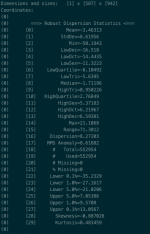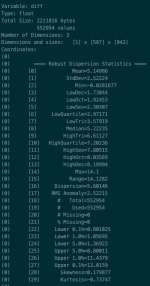Dear all,
Here I'm seeking some help with respect to surface upwelling longwave radiation in WRF v4.1.4. It was run with convection-permitting capabilities (4-km horizontal resolution, 65 vertical layers) during 2011 May-Aug, with the following configurations:
Microphysics: Morrison double-moment scheme.
Longwave radiation: RRTMG. Iacono et al. (2008, JGR)
Shortwave radiation: RRTMG. Iacono et al. (2008, JGR)
Surface Layer (sf_sfclay_physics): MYNN surface layer. Nakanishi and Niino PBL’s surface layer scheme.
Land-surface option: Noah-MP (multi-physics) Land Surface Model.
Planetary Boundary layer option: MYNN 3rd level TKE. Nakanishi and Niino (2006, BLM)
In the WRF simulations, supposedly, surface longwave upwelling radiation (variable LWUPB) should equal to EMISS*sigma*TSK^4, where variable EMISS is surface emissivity, variable TSK is the surface skin temperature, sigma is the Stefan-Boltzmann constant. However, when checked (see in figures), they do not equal to each other. The differences can go as high as 20 W/m2.
In the attached figures, first row shows LWUPB from WRF model outputs, the 2nd row shows the results from EMISS*sigma*TSK^4, the last two rows show differences between LWUPB and (EMISS*sigma*TSK^4) with single and double precisions. The value of sigma uses 5.67 * 10.0**(-8). Two figures show results at two different timestamps.
Has anyone seen similar symptoms in the WRF outputs? Are there ways to explain the differences between LWUPB in the model output and the re-constructed surface longwave upwelling radiation by using (EMISS*sigma*TSK^4)?
Any comments are greatly appreciated!
-----
Updates:
In module_sf_noahdrv.F file, found this line of code:
rl_up_rural=-emiss_rural(i,j)*sigma_sb*(tsk_rural(i,j)**4.)-(1.-emiss_rural(i,j))*glw(i,j)
The negative sign seems to indicate directions and the surface longwave upward radiation seems equal to emissivity * sigma * TSK^4 + (1-EMISS)*GLW, where GLW is downward longwave at ground surface. Tried this new method and found the differences between LWUPB and [emissivity * sigma * TSK^4 + (1-EMISS)*GLW] to be smaller than the previous method. However, the differences are still not zero (see newly attached figures). Scratching my head to figure out why...
Kind regards,
HC
Here I'm seeking some help with respect to surface upwelling longwave radiation in WRF v4.1.4. It was run with convection-permitting capabilities (4-km horizontal resolution, 65 vertical layers) during 2011 May-Aug, with the following configurations:
Microphysics: Morrison double-moment scheme.
Longwave radiation: RRTMG. Iacono et al. (2008, JGR)
Shortwave radiation: RRTMG. Iacono et al. (2008, JGR)
Surface Layer (sf_sfclay_physics): MYNN surface layer. Nakanishi and Niino PBL’s surface layer scheme.
Land-surface option: Noah-MP (multi-physics) Land Surface Model.
Planetary Boundary layer option: MYNN 3rd level TKE. Nakanishi and Niino (2006, BLM)
In the WRF simulations, supposedly, surface longwave upwelling radiation (variable LWUPB) should equal to EMISS*sigma*TSK^4, where variable EMISS is surface emissivity, variable TSK is the surface skin temperature, sigma is the Stefan-Boltzmann constant. However, when checked (see in figures), they do not equal to each other. The differences can go as high as 20 W/m2.
In the attached figures, first row shows LWUPB from WRF model outputs, the 2nd row shows the results from EMISS*sigma*TSK^4, the last two rows show differences between LWUPB and (EMISS*sigma*TSK^4) with single and double precisions. The value of sigma uses 5.67 * 10.0**(-8). Two figures show results at two different timestamps.
Has anyone seen similar symptoms in the WRF outputs? Are there ways to explain the differences between LWUPB in the model output and the re-constructed surface longwave upwelling radiation by using (EMISS*sigma*TSK^4)?
Any comments are greatly appreciated!
-----
Updates:
In module_sf_noahdrv.F file, found this line of code:
rl_up_rural=-emiss_rural(i,j)*sigma_sb*(tsk_rural(i,j)**4.)-(1.-emiss_rural(i,j))*glw(i,j)
The negative sign seems to indicate directions and the surface longwave upward radiation seems equal to emissivity * sigma * TSK^4 + (1-EMISS)*GLW, where GLW is downward longwave at ground surface. Tried this new method and found the differences between LWUPB and [emissivity * sigma * TSK^4 + (1-EMISS)*GLW] to be smaller than the previous method. However, the differences are still not zero (see newly attached figures). Scratching my head to figure out why...
Kind regards,
HC










